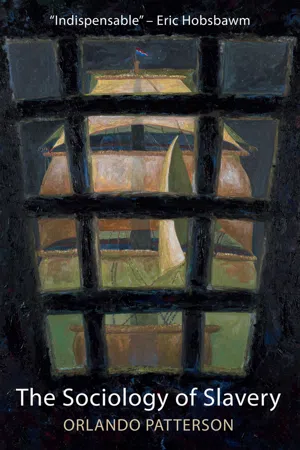
- English
- ePUB (mobile friendly)
- Available on iOS & Android
About This Book
Orlando Patterson's classic study of slavery in Jamaica reveals slavery for what it was: a highly repressive and destructive system of human exploitation, which disregarded and distorted almost all of the basic prerequisites of normal social life. What distinguishes Patterson's account is his detailed description of the lives and culture of slaves under this repressive regime. He analyses the conditions of slave life and work on the plantations, the psychological life of slaves and the patterns and meanings of life and death. He shows that the real-life situation of slaves and enslavers involved a complete breakdown of all major social institutions, including the family, gender relations, religion, trust and morality. And yet, despite the repressiveness and protracted genocide of the regime, slaves maintained some space of their own, and their forced adjustment to white norms did not mean that they accepted them. Slave culture was characterized by a persistent sense of resentment and injustice, which underpinned the day-to-day resistance and large-scale rebellions that were a constant feature of slave society, the last and greatest of which partly accounts for its abolition.
This second edition includes a new introduction by Orlando Patterson, which explains the origins of the book, appraises subsequent works on Jamaican slavery, and reflects on its enduring relevance. Widely recognized as a foundational work on the social institution of slavery, this book is an essential text for anyone interested in the role of slavery in shaping the modern world.
Frequently asked questions
Information
CHAPTER VII
Social Institutions of the Slaves
1. WITCHCRAFT, SORCERY AND RELIGION
PART I
SUPERNATURAL BELIEFS AND PRACTICES OF AFRICAN ORIGIN
Witchcraft beliefs enable a society to go on functioning in a given manner, fraught with conflicts and contradictions which the society is helpless to resolve; the witchcraft beliefs thus absolve the society from a task apparently too difficult for it, namely, some radical readjustment.9
Table of contents
- Cover
- Dedication
- Title Page
- Copyright
- Introduction to the 2022 Edition: Life and Scholarship in the Shadow of Slavery
- Preface
- I The Masters: An Overall View of Slavery
- II The Slave Plantation: Its Socio-Economic Structure
- III The Treatment of the Slaves in Law and Custom
- IV An Analysis of the Slave Population of Jamaica
- V The Tribal Origins of the Jamaican Slaves
- VI The Socialization and Personality Structure of the Slave
- VII Social Institutions of the Slaves: 1 Witchcraft, Sorcery and Religion
- VIII Social Institutions of the Slaves: 2 Economy, Recreation and Control
- IX The Mechanisms of Resistance to Slavery 260
- X The Cultural and Social Development of Jamaica: 1655–1865
- Appendix 1: Stephen Fuller’s Account of the Number of Negroes imported and exported at Jamaica each year, 1702–1775
- Appendix 2: Exports from Jamaica, 1768
- Appendix 3: General Return from the Island of Jamaica, for Fifty-Three Years, ending 31st December 1836, abstracted from the Journals of the House Assembly
- Appendix 4: Output, Income and Expenditure in 1832
- Appendix 5: Manuscripts and Official Publications Consulted
- Appendix 6: Europeans in West Africa; Seventeenth to Eighteenth Centuries
- Appendix 7: Africa as known to Europeans in the Mid- Eighteenth Century
- Plate Credits
- Index
- Plates
- End User License Agreement